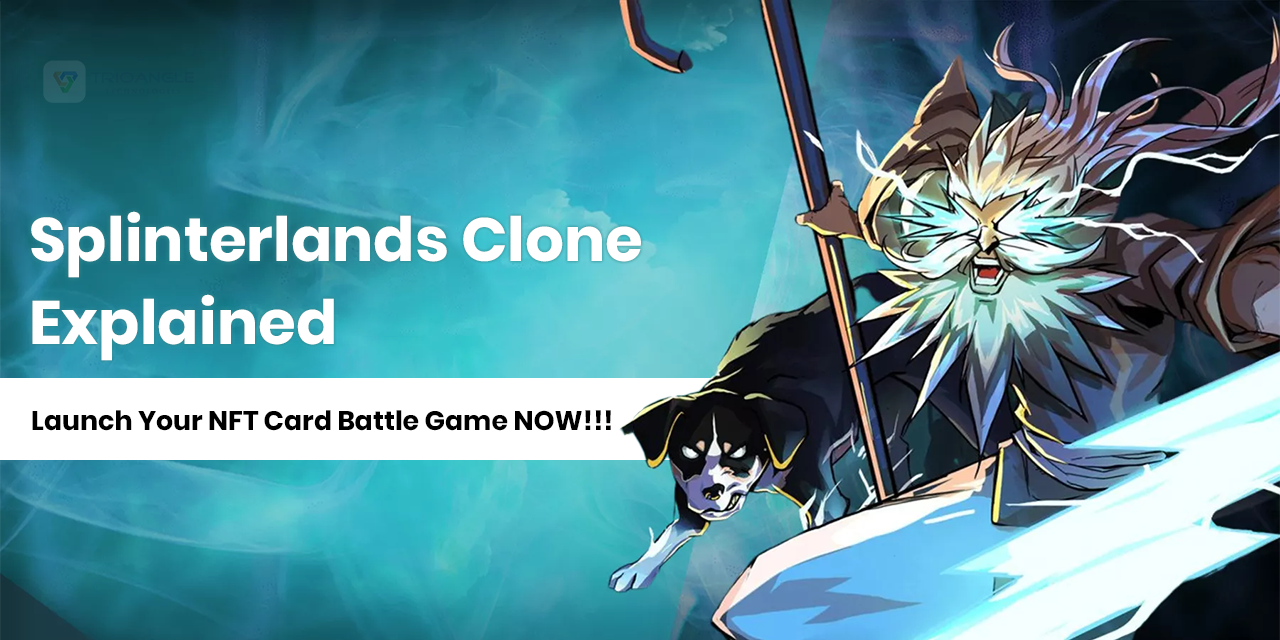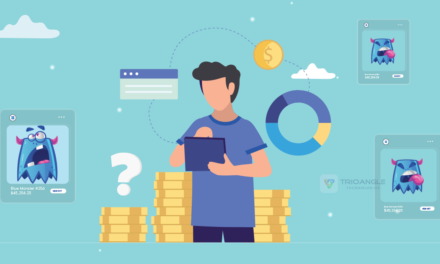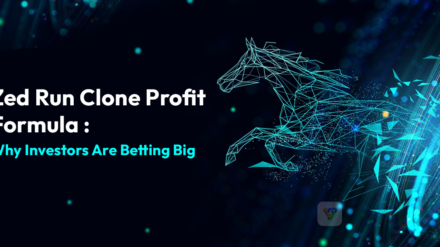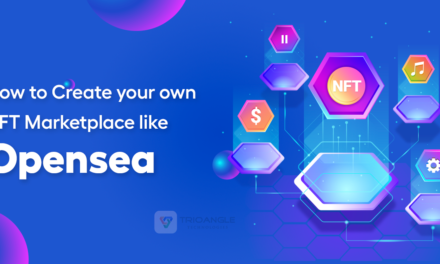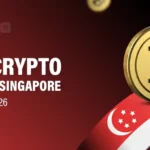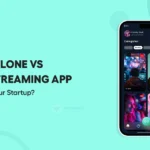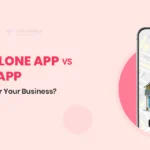Very few games actually hand over the keys to the players. Splinterlands did!!! And that’s why it’s more than just a card game. Splinterlands clone proves that gameplay when combined with real asset control. It becomes something players don’t just play they invest in.
You’re not just launching a card battle game. It’s an economy, a strategy war zone, and a trading marketplace all wrapped into one. If you’re eyeing this NFT Marketplace Clone Script, timing is everything. Now’s the time to decode its core logic and turn it into your next big win.
Let’s break it down, feature by feature.
What is Splinterlands Clone?
Splinterlands Clone refers to a customized version of the original Splinterlands game. A leading NFT card battle game rebuilt with similar mechanics. Tech stack, and game economy but under your brand and control.
- Originally launched as a blockchain-based digital trading card game.
- Splinterlands blends collectible NFT cards with play-to-earn dynamics.
- Allowing players to earn crypto rewards through tactical card battles.
What makes it stand out is its fast-paced, auto-battler style and card ownership model. Where every asset is an NFT you truly control.
A Splinterlands Clone NFT card game captures this core idea. But lets you reshape the rules, card sets, lore, token economy, and marketplace. Entrepreneurs now see it as a serious gateway to enter the fast-growing play-to-earn NFT games space.
The original game runs on Hive blockchain. And integrates with Ethereum and WAX for NFT liquidity.
A well-built digital card game like Splinterlands opens new doors not just in gaming. But in ownership-led ecosystems, where both play and trade matter equally.
How to build a Splinterlands clone game ?
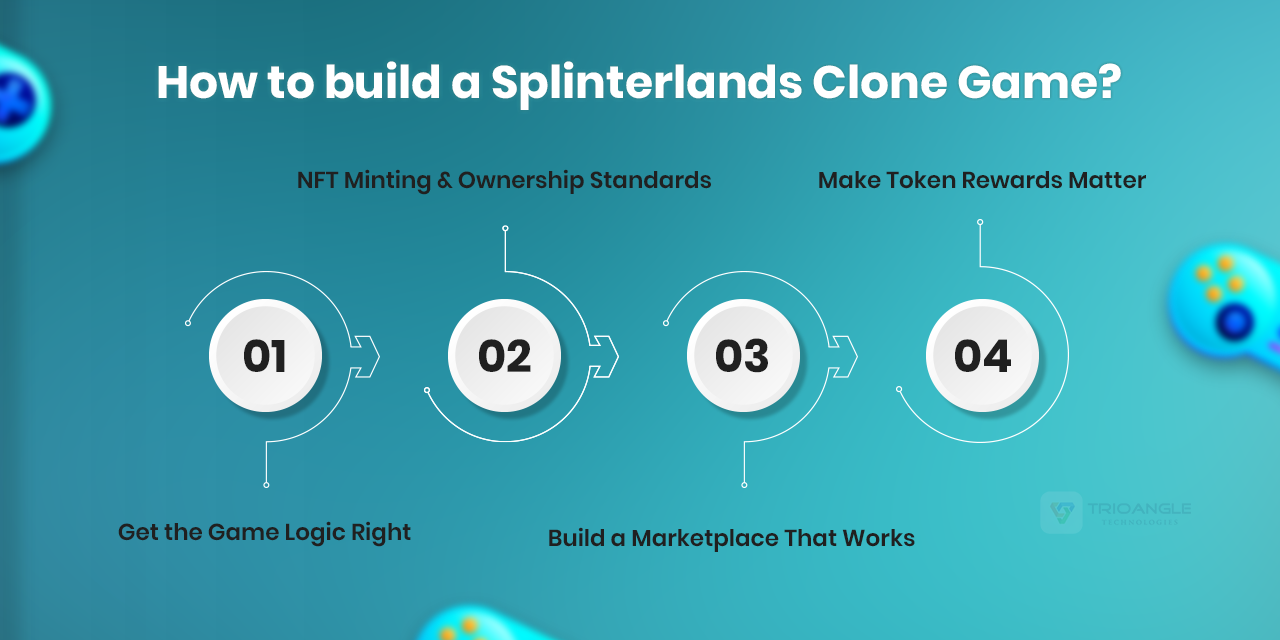
Creating a play‑to‑earn card game clone of Splinterlands isn’t about mimicking a layout. It’s about engineering a full-circle game economy, community trust, and player value.
Here’s how to approach it like a builder, not a borrower.
Step 1: Get the Game Logic Right
At its heart, Splinterlands is a skill-based strategy game. You’ll need to build a turn-based logic system that calculates battles based on cards, abilities, and mana costs. The outcome must feel unpredictable. But fair means tight math, smart algorithms, and zero lag. Build it in Unity, Phaser, or Godot depending on your vision. Make it web-first, with mobile optimization baked in.
Step 2: NFT Minting & Ownership Standards
Cards should be minted as NFTs ideally using ERC-1155. Or a custom Hive-compatible wrapper. What sets a NFT-Based Digital Card Game like Splinterlands apart is that every card must have provable scarcity, upgradability, and in-game utility. That means you’ll need an on-chain metadata system for tracking level-ups… Burns, and fusions just like in the official game.
Step 3: Build a Marketplace That Works
Splinterlands doesn’t just stop at battles. Its integrated NFT marketplace like Splinterlands is where most of the action happens. Build yours with buy/sell/rent capabilities, filters by rarity, and staking mechanics. Use AI to recommend listings and predict card values dynamically based on battle popularity.
Step 4: Make Token Rewards Matter
You’re not just launching a game. You’re launching a micro economy. Your Splinterlands Clone must have its own utility token, reward pools, and anti-inflation mechanics. Use smart contracts to distribute P2E rewards, and let players earn without whales dominating the system.
How Does the Splinterlands Clone Work?
A Splinterlands Clone works by replicating the gameplay mechanics. Blockchain integration, and NFT marketplace flow of the original Splinterlands. But with options to customize everything from card lore to tokenomics.
Let’s break down the actual user workflow:
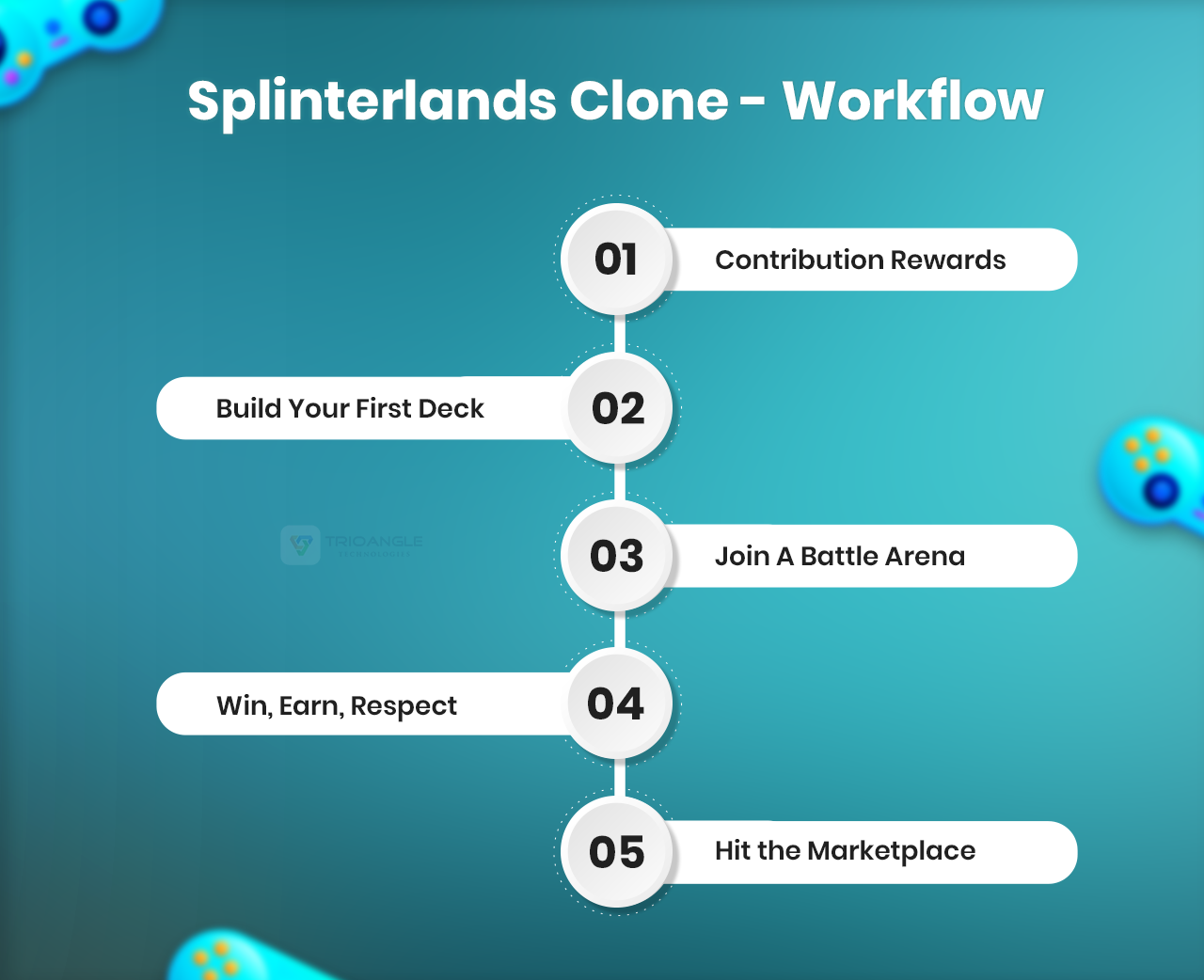
#1 Start at Sign-Up: Onboard Like a Game
Most users aren’t crypto-native, so we start simple. Players can register using just their email. plug in a wallet like MetaMask or WalletConnect. Right after sign-up, they receive a free set of non-transferable starter cards. (just like the original Splinterlands). This means users can jump into the action before they even buy or trade an NFT.
#2 Build Your First Deck
Now the fun begins. Inside the game, users explore their card inventory. Each card is an NFT stored on-chain with stats like health, attack type, and rarity. It determines how it behaves in battle. These aren’t only digital assets. They’re programmable game pieces backed by smart contracts.
#3 Join a Battle Arena
Here’s where your backend engine kicks in. Players enter matches based on league or rank. The system randomly generates match rules (like “No Magic” or “Double Speed”).
Using AI-enhanced matchmaking, opponents are paired based on rank and previous performance. Once teams are locked, the NFT card battle game auto-runs using deterministic logic. No click-spamming or RNG chaos.
#4 Win, Earn, Repeat
Winners earn native tokens or NFTs, depending on the match type. Rewards are distributed via smart contracts tied to player ranks, activity, and token holding status. These rewards fuel the game economy and create a circular incentive. This is your play-to-earn game loop.
Better cards mean stronger decks. Stronger decks mean more wins. More wins mean more rewards.
#5 Hit the Marketplace
The official Splinterlands marketplace shows real-time card demand. Your play-to-earn card game clone of Splinterlands should go further. Adding AI features like card price predictors, usage heatmaps, and auto-rent recommendations. To help users optimize their decks and portfolios.
Premium Features of the Splinterlands Clone
Tournaments
Tournaments are the heartbeat of competitive engagement. Built-in with seasonal prize pools and entry fees. You can let players stake their cards and test their decks against high-level competition. Smart contracts handle fair payouts instantly based on ranks.
Guild System
Guilds offer more than community. They unlock features like shared buildings, pooled rewards, and exclusive brawls. A guild-based layer helps scale your digital trading card game into a social MMO-style network. It makes group strategy part of the meta.
Card Flipping
Think of this like a gamified NFT swap. Card flipping lets users buy packs, reveal them. And flip high-demand NFTs instantly in your NFT marketplace like Splinterlands. It builds anticipation, encourages micro-trading, and fuels economic liquidity.
Burning Cards
In a NFT-Based Digital Card Game like Splinterlands… Players can permanently destroy unwanted cards to receive in-game currency or crafting material. This helps stabilize supply and gives players reason to trim their decks.
Card Merging
Players can merge identical cards to level them up. Merging not only improves stats but also affects card scarcity and secondary value. This feature boosts both gameplay strength and collectible worth. Key for long-term retention in play-to-earn NFT games.
Leaderboard & Seasons
Leaderboards track top players across ranked matches, quests, and guild brawls. Season-end rewards in tokens, cards, or boosts. It give a compelling reason to grind and stay active in your Splinterlands Clone.
In-game Chat & Social Features
Social features aren’t optional anymore. Integrated chat lets players discuss strategy, trade offers, or challenge rivals directly. You’re not just building a game. You’re creating a real-time, human-powered marketplace of ideas and trades.
Quests & Daily Missions
Quests challenge players to use underplayed cards, diversify tactics, and complete daily goals. Combined with token rewards and loot packs, it adds daily stickiness to your NFT card battle game.
Game Assets of Splinterlands Clone Script
Types of Cards
Cards are the foundation. Summoners determine your team’s buffs and magic affinities. While Monsters carry out the attacks. Special ability cards can introduce twists like sneak attacks or healing effects. It adds surprise layers to each match.
Six Elements of Magic
Each card is tied to one of six elements: Fire, Water, Earth, Life, Death, and Dragon. These aren’t just aesthetic. They influence stats, abilities, and synergy. A NFT-based digital card game like Splinterlands thrives on elemental matchups… that shift with every ruleset.
Playable NFTs
Every card is a playable NFT. Fully tradable, rentable, and upgradable. The metadata tracks ownership, level, battle history, and cooldowns. This makes your play-to-earn NFT game both transparent and deeply replayable.
Items & Boosts
Items and consumables can boost speed, attack, or defense for one match. They introduce short-term strategy into long-term decks. It helps balance out uneven matchups without breaking the game’s fairness logic.
Battlefield Grid
The battlefield isn’t a flat list. Card position matters. Some attack from the front, others from the back. A play-to-earn card game clone of Splinterlands should keep this spatial combat grid to reward tactical thinking.
Mana Cap System
Each battle comes with a mana limit. This forces players to make tough trade-offs. Go with a few strong cards or a swarm of weaker ones? It ensures balance and keeps whales from dominating purely through power.
Combat Rulesets
The real genius of a trading card game like this lies in shifting rulesets. One match may ban ranged attacks, the next may double health. It prevents repetition and rewards deck versatility.
Skill-Based Deck Building
Deck-building isn’t random. It’s a test of memory, timing, and adaptation. The best Splinterlands Clone games offer AI-driven suggestions. But leave the final strategy to the player, making every win feel earned.
Play-and-Earn Opportunities Built into the Splinterlands Clone
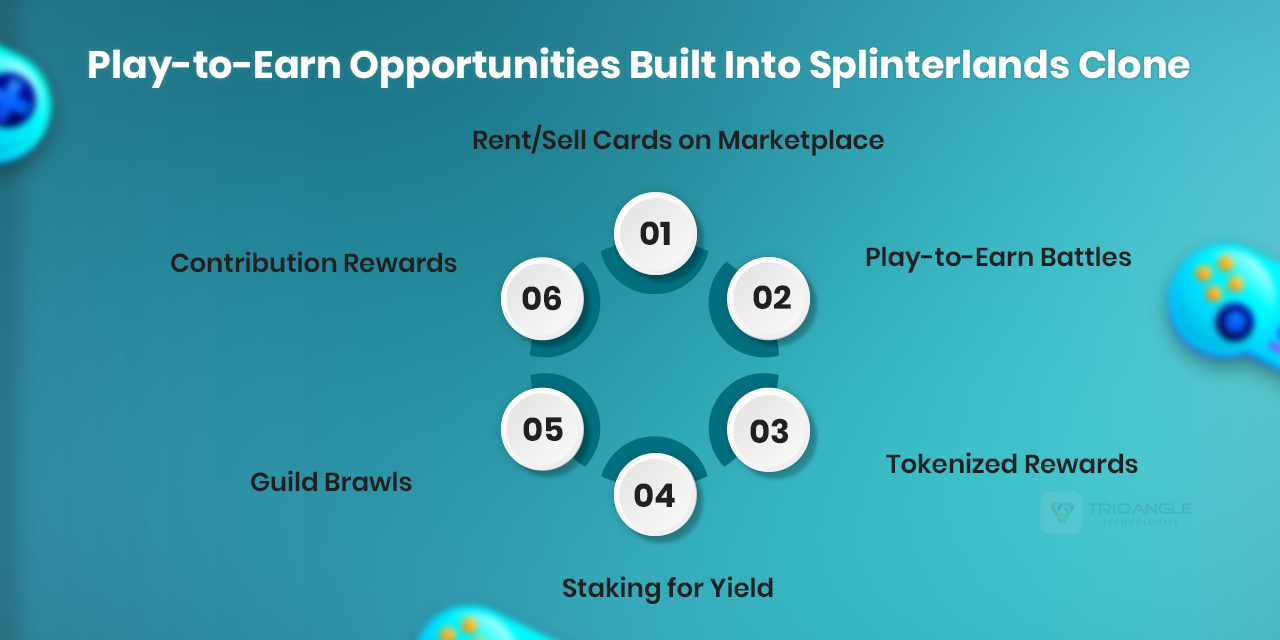
Rent or Sell Cards on Marketplace
Not every player needs to own every card. Through a NFT marketplace like Splinterlands… Users can rent out powerful cards to others for a daily fee. Rentals are handled through smart contracts, making transactions trustless and secure.
Play-to-Earn Battles
Each ranked battle can earn players tokenized rewards, card drops, or XP based on performance. The better the strategy, the higher the payout. A strong digital trading card game loop always includes competitive matches. It feel worth the grind.
Tokenized Rewards
Instead of just virtual points, players earn real crypto, native tokens or stablecoins. Depending on their league and activity. Tokens can be used in-game or traded externally. It gives your Splinterlands Clone actual liquidity and off-chain utility.
Staking for Yield
Players can stake tokens or even NFTs to receive passive rewards over time. In some cases, staking also unlocks exclusive tournaments or card packs. It’s a smart way to combine DeFi logic with a NFT card battle game experience.
Guild Brawls & Contribution Rewards
Players earn based on their participation. In guild brawls, shared buildings, and donation pools. Contribution-based payouts give long-term players a deeper reason. To stay loyal to your NFT-Based Digital Card Game like Splinterlands.
Key Modules Integrated into the Splinterlands Clone Marketplace
NFT Marketplace
The marketplace is fully decentralized. Allowing users to buy, sell, and rent NFT cards directly from their wallets. Each card listing includes metadata like stats, usage history, and rarity. Critical for informed decisions in a play-to-earn card game clone of Splinterlands.
Market Analytics
Dynamic analytics show pricing trends, demand spikes, and volume metrics. Just like in the official NFT marketplace like Splinterlands… this data fuels smart decisions. Layer in AI to predict card value fluctuations based on battle win rates and seasonal usage.
Token Integration (SPS, DEC)
Built-in support for SPS, DEC, or your own token standard ensures seamless transactions. Tokens aren’t just for trading. They’re used for entry fees, upgrades, staking, and governance in your NFT-based digital card game like Splinterlands.
Wallet Support
The marketplace supports Hive, WAX, MetaMask, and more. Whether your user prefers Web2 or Web3 entry points… Login and transactions remain smooth. It’s how you keep engagement high without friction.
Smart Contract Integration
Every card sale, rental, or merge is governed by smart contracts. These ensure transactions are immutable and transparent. Backbone essentials for any play-to-earn NFT game with real-world value flow.
Cross-chain Compatibility
Integrating bridges with chains like BSC, Ethereum, and Polygon. Lets users import/export NFTs or liquidity. This widens your player base and turns your Splinterlands Clone into a truly borderless digital trading card game economy.
What Role WAX Blockchain Plays in Your Splinterlands Clone’s Blockchain Logic
WAX doesn’t only handle transactions. It shapes how your Splinterland clone breathes.
- It’s the reason Splinterlands can mint thousands of NFT cards without breaking speed or budget.
- WAX’s carbon-neutral design and micro-fee model let you scale player actions. Like card trades, rentals, or staking without friction.
- Plus, its cloud wallet system simplifies onboarding for non-crypto players. That’s a huge win if you’re aiming for a mainstream audience.
- WAX gives your game low-cost operations, real-time asset logic, and seamless NFT movement all built into the core loop.
Your Next Move!!!
A Splinterland clone isn’t about catching up. It’s about leveling up!!! Game logic, token dynamics, user retention, and true digital ownership. You’re not entering a market just to compete… you’re setting a foundation to lead in the next phase of NFT card battle games.
When every mechanic is backed by purpose from WAX integration to cross-chain assets. You’re building something players notice and stay for via the right NFT Marketplace clone script.
The real win? You control the economy, the experience, and the evolution. So don’t just clone, customize, optimize, and own your game’s future. The arena’s open. Now it’s your move.

